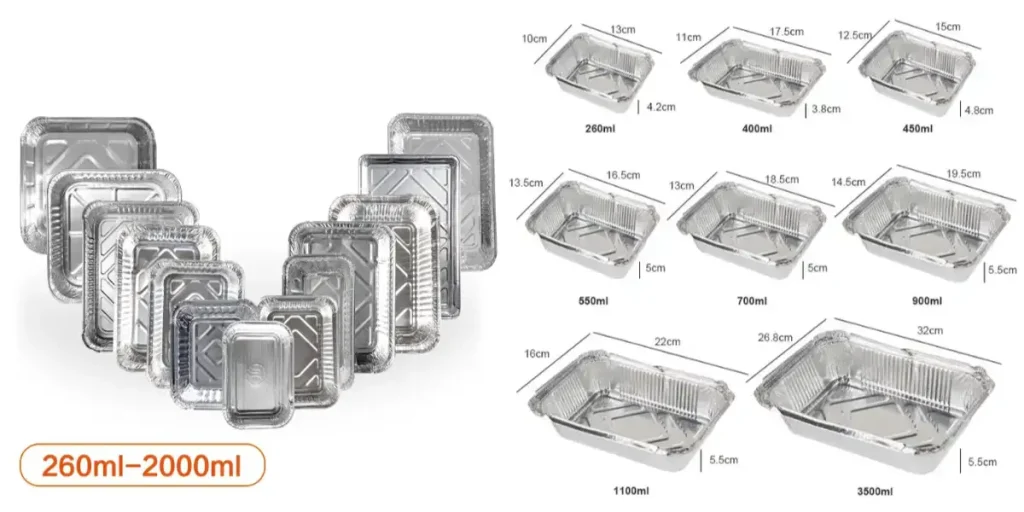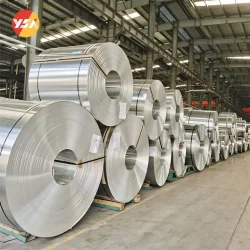Container aluminum foil is a lightweight and versatile material designed for food packaging containers. Made from high-quality aluminum alloy, it provides excellent barrier properties against oxygen, moisture, and light, ensuring the freshness and quality of food products. With its heat resistance, it can withstand high temperatures during cooking and reheating. Its flexibility and formability allow for easy shaping and convenient storage of various food items. Additionally, its lightweight nature makes it easy to handle and stack, making it an ideal choice for the food service industry.
Yongsheng Container Aluminum Foil
The most common state and alloy type for container aluminum foil is the 8011-o state, or the tougher one like 3004 alloy.
| Alloy | 1xxx Series: 1050, 1060, 1070, 1100, 1235 |
| 3xxx Series: 3003, 3004 | |
| 5xxx Series: 5052 | |
| 8xxx Series: 8011, 8021, 8079 | |
| Temper | F, O, H14, H16, H18, H19, H22, H24, H26, H28, T etc. |
| Thickness | 0.03-0.2mm |
| Capacity | ≥100ml |
| Shape | Square, Rectangular, Round, Customizable |
| Size | 200+ Type of Sizes |
| Applications | Cooking, Freezing, Baking and More |
| Delivery Time | Ready stock 7-10 days, on time delivery |
| Loading Port | Qingdao Port, Tianjin Port, Shanghai port. |
| Price Terms | FOB, CIF, CFR, CNF, etc. |
| Quality Control | Mill Test Certification is supplied with shipment, Third Party Inspection is acceptable. |

Are aluminum containers safe?
Aluminum is one of the most abundant metals on Earth.
In its natural state, it combines with other elements such as phosphates and sulfates found in soil, rocks and clay. However, it is also found in small amounts in air, water and food.
In fact, it occurs naturally in most foods, including fruits, vegetables, meats, fish, grains and dairy products. Some foods, such as tea, mushrooms, spinach and radishes, also absorb and accumulate it more readily than others. In addition, some of the aluminum you eat comes from processed food additives such as preservatives, colorants, anti-caking agents and thickeners.
Melting point of aluminum foil

Aluminum foil is mainly composed of pure aluminum. Aluminum ingots are melted and annealed, rolled repeatedly until they form sheets with a thickness of less than 0.2mm, and then rolled up to become large rolls of aluminum foil. Melting point of aluminum foil is 660 degrees Celsius, or 1220°F. So aluminum foil is very stable at normal cooking temperatures.
Can you put aluminum foil in the air fryer?
To determine can you put aluminum foil in the air fryer, we first need to know how an air fryer works.
Air fryers heat food by using a powerful heating element located at the top of the appliance to generate intense heat. This heat is then circulated rapidly within the cooking chamber by a high-speed fan. As the hot air circulates around the food, it transfers heat energy to the food’s surface, creating a crisp and browned exterior. The hot air cooking method mimics the effects of deep-frying but with significantly less oil or even no oil at all. The precise temperature control allows for even and consistent cooking, resulting in food that is crispy on the outside while maintaining moisture and tenderness on the inside.
The temperature to which the air can reach in an air fryer can vary depending on the specific model and brand. In general, most air fryers have a temperature range of approximately 180°C to 200°C (350°F to 400°F).

As we said before, aluminum foil is very stable at this temperature, nowhere near the temperature that would allow the foil to change its states.
Aluminum foil is not dangerous, but it can increase the amount of aluminum in your diet by a small amount.
If you are concerned about the amount of aluminum in your diet, you may need to stop cooking with aluminum foil.
However, the contribution of aluminum foil to your diet may be negligible. Because the amount of aluminum you may be consuming from aluminum foil is much lower than the amount of aluminum considered safe, you don’t need to worry about the trace amounts of aluminum foil you are consuming from cooking. But avoid mixing aluminum foil with acidic foods when using aluminum foil or aluminum containers: avoid exposing aluminum foil or cookware to acidic foods.
The actual amount of aluminum in the food you eat depends to a large extent on the following factors:
Soil: the aluminum content of the soil in which the food is grown
Additives: whether certain additives have been added to the food during processing
Aluminum can also be ingested through medications that are high in aluminum, such as antacids.
In any case, the amount of aluminum in foods and medications is not considered a problem because only a small amount of the aluminum you ingest is actually absorbed.
In healthy people, the absorbed aluminum is subsequently excreted in the urine or in your feces.
So, the small amount of aluminum you consume each day is considered safe.

